
GRAVENSTEEN CASTLE
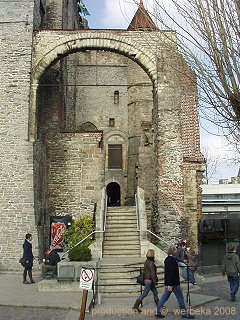 |
The castle of Gravensteen is situated in Ghent, in the middle of the town. Half of the building borders a natural water hinder, the river Leie, which was an enormous advantage for the defence of the castle. It is said, that the castle is the only place in the country, where today you still can see the living conditions of the inhabitants during the Middle Ages. This seems to be very true, because seen from some distance, the castle looks rather stable, but sinister. By this you are reminded of the fact, that a castle also was a place of refuge and harbourness during attacks of some enemy. This becomes even more evident, when you leave a minor street and suddenly stand in front of that giant outer portal, which once was the first line of defence.
In the second, inner port of the castle, before you enter the big yard, there is a pedigree over the first rulers of this part of the country. |
| History starts with Baldwin with the iron arm, who protected the area against the attacks from the Vikings. That was in the 9th century and Baldwin did that from a base with a fortified house, standing at this spot. In the late 11th century Robert the Frisian built a house of stone with the dimensions of 33 x 19 m, in which the walls were two meters thick.
But the castle of today was built by Count Philip of Alsace in 1180. He had become inspired by the castles of his fellow knights, which he saw on his crusade to Palestine. Thus there are many similarities to be found with castles farther to the east.
Visiting the castle is regulated in an as simple as ingenious way. All over the place there are numbered signs, which partly - in Flemish, French, English and German - give you a description of which kind of room you are in, partly mark with a dot on a map, where you are for the moment and finally show with an arrow in which direction to proceed. This is very practical as everybody can make the tour at his own pace.
|
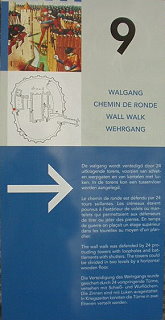 |
The first room one gets to see is the Big Hall or even called Knight's Hall, in the middle of the castle. The walls are partly the same that were used to build the first house of stone - they are no less than 900 years old! When Philip built his new castle, he had heightened the ground in that way, that the earlier ground level now became the cellar. In Robert's old house the floor of that room was at the same level as the surface of the water of the river Leie. This prevented that any enemy would be able to dig out a tunnel under the wall.
In this Hall the Count held his meetings and signed treaties.
|
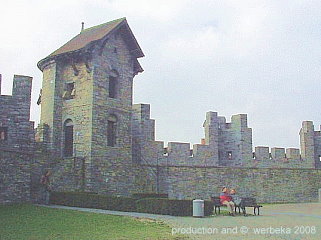
The outer wall, going down to the river Leie |
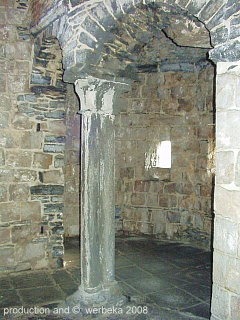
The old walls, which surround you everywhere, contribute to the atmosphere |
Even if Gravensteen literally means Count's Stone, that is "the Count's Castle", and even if the counts lived in a house of their own, at the side of the tower, but still within the walls, they have not stayed overnight very often. Partly this is due to the fact that they had a lot of castles all over the region and must maintain their interest everywhere. So they couldn't be in Ghent all the time.
|
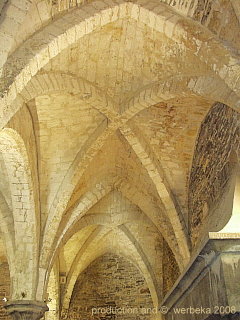
The cross-vaults make the visitor think of the well-founded architecture at that time. |
But partly that was because there were better places to spend the night, like one of the cathedrals in town. The relation between the monks and the counts was not always very good, though. The clergymen often despised the uneducated counts, who neither could read nor write, but only ruled through sheer violence - but the counts had, as it had been forever, the power of strength on their side. How little the world changes! Burning books and prosecution of intellectuals are even today a much preferred manner of ruling for some tyrants ...
In times of peace the castle mainly served as a symbol of power and strength, then as a building for representative actions and as a court - and only lastly as a place to live in. An administrator was put into place to take care of the daily routines.
Of course it was the count himself, who took care of the jurisdiction, at least as long as the era of chivalry went on. But even later there was a court and people were sentenced in the castle. Between 1407 and 1778 the Council of Flanders, which was the highest court of law in the country, held its meetings in the castle. The guillotine, which is to be seen on the picture, is just an imitation, but the blade is original ...
An observant reader will ask now, how a guillotine could be used at such early times. Right you are. The French doctor Joseph-Ignace Guillotin "discovered" this death-machine first in 1789. But similar constructions with falling blades had been known earlier, the first ones being reported from the 12th century.
The visitor gets to see more than only the old walls of the castle, as there are two museums within it. |
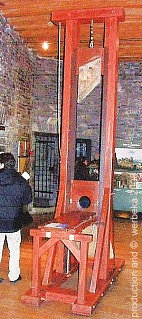 |
The first of them is located in the armoury, where a collection of weapons is to be seen. An entire suit of armour dominates the centre of the room and all around there are different weapons in the display cases.
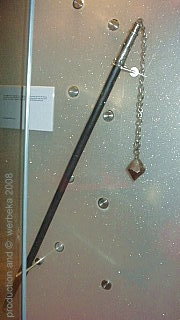 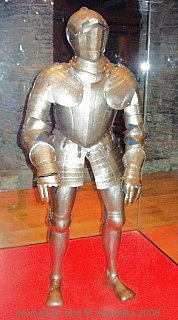 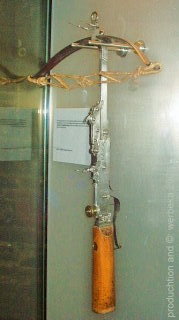 Apart from a multitude of spears, lances, swords, etc. there is a beautifully manufactured crossbow and a flail. The latter has emerged from the boor, used for threshing, which the peasants used, when going to battle, as they had no other weapons.
Apart from a multitude of spears, lances, swords, etc. there is a beautifully manufactured crossbow and a flail. The latter has emerged from the boor, used for threshing, which the peasants used, when going to battle, as they had no other weapons.
After a short visit on the roof, from where you have a magnificent view over the skyline of Ghent, it goes downwards on very steep and narrow stairs. Now you come into the second museum, where mostly assets of torture are displayed.
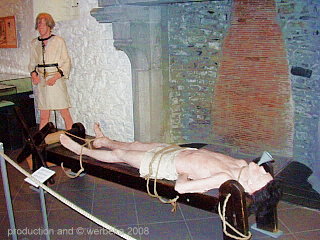 |
Again I must note, that the world today is as cruel as it is shown on the picture, a scene from 900 years ago. Today the CIA calls it "waterboarding" ...
But maybe the interrogation-leaders still could learn a thing or two. The iron necklace was a favoured gadget for torture. It is a metal ring, with very sharp spikes on the inside. This ring is put around the neck of the delinquent and afterwards it is fastened tightly at two points in the room, in such way that the vitim cannot move, neither fall asleep, of course, without hurting himself severely. But, I admit, you get a confession quicklier, when practising waterboarding. |
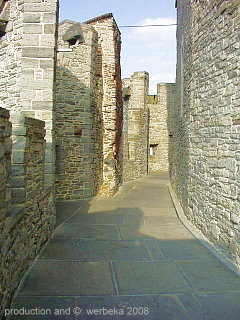 |
Slightly disgusted I continue and soon stand on the battlement, leading all around the outer wall. On the backyard, there is an abandoned slingshot, which makes one think of sieges. Actually the castle was besieged twice during the first half of the 14th century.
But it was no foreign army that tried to capture it. It were the inhabitants of Ghent, who revolted against the authorities and twice they were successful. |
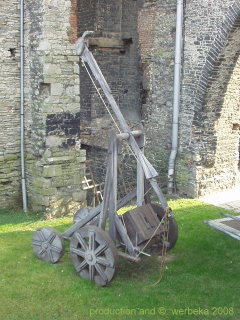 |
Once the occupants of the castle were smoked out and the second time the people of Ghent succeeded in digging a hole into the wall.
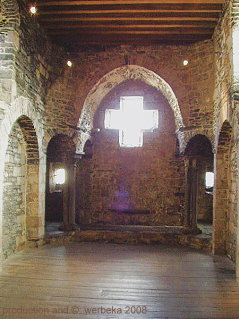 |
At the rear part of the castle, there is the old kitchen, of which the ruins never were restored. Here they prepared the meals for the feasts of the count. Game was of course a main ingredient of a meal - hare, deer, roe and wild boar. Interestingly enough, even normal pork was looked at as more baronial food than that of common people. But, if it hadn't been extinguished in this area already in the 12th century - serving brown bear would have been an unsurpassable sign of power and dignity.
From the battlement and over a flight of winding stairs you reach the room with the cross-formed window, which attracts your attention already when looking at the castle from the outside. It is supposed, although there is no evidence for it, that there was a chapel in this room, for the soldiers of the sovereign and for the guards of the castle. |
| The last stations of the guiding tour are today's basements of the house, which in case of the so-called crypt earlier was on ground-level, at the same level as the surface of the river. One guesses that these were the stables for the horses, but also, that the horse-keepers slept together with the animals.
Finally, beneath the house of the count, at the wall, there is the repository. At least it was used as such during the Middle Ages, as long as the castle fulfilled its proper function. Later, in the "era of enlightenment", it was used by the inquisition as chamber of torture ...
From the curiosities of the castle's history should be mentioned that it was passed into private hands, that is to say, that its chambers were let. Throughout the most part of the 19th century a cotton mill was among the tenants.
|
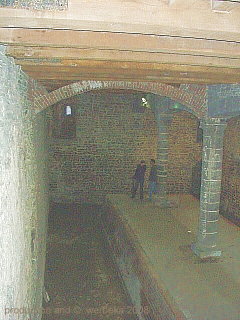 |
© Bernhard Kauntz, Västerås 2008
Back to  or to the or to the  of of 
last update: 18.3.2008 by webmaster@werbeka.com
|
















